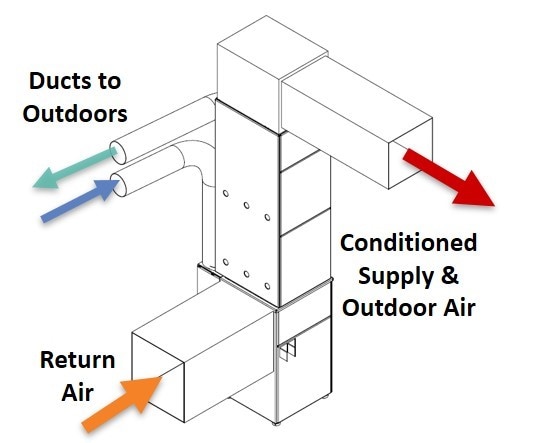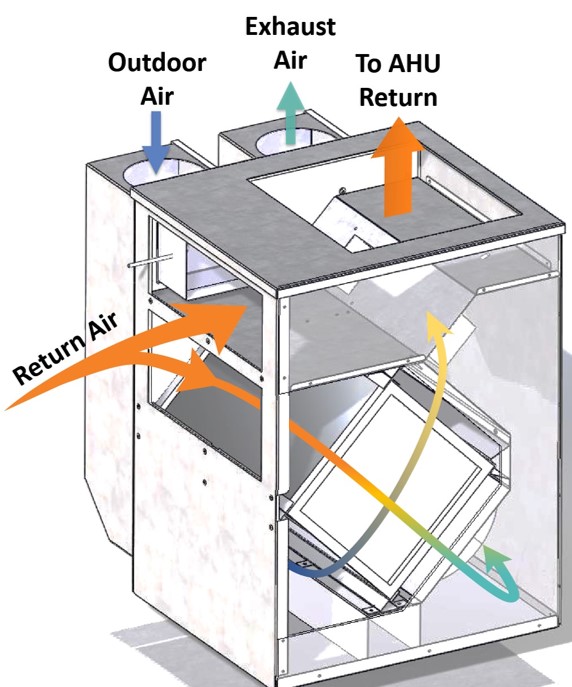

Blog
Everyone pretty much gets that continuous (or very frequent) ventilation is necessary in high-performance homes. And – at least in theory – most people get why balanced, heat recovery ventilation is better (than unbalanced and/or without heat recovery). But the devil’s in the details.

Everyone pretty much gets that continuous (or very frequent) ventilation is necessary in high-performance homes. And – at least in theory – most people get why balanced, heat recovery ventilation is better (than unbalanced and/or without heat recovery). But the devil’s in the details.
A couple years ago we started an R&D project with funding from DOE’s Building America program, and one of the first steps was interviewing several developers about ventilation (single- and multi-family residential, mostly on the East Coast). For none of these developers were HRVs or ERVs standard.[1] They all had some experience with ERVs, however, and when asked about these experiences the word “nightmare” came up shockingly often.
The ERVs on the market now can certainly work well in the right application, but we see problems more often than not. One of the biggest challenges is trying to add ERVs on to central heating/cooling systems in homes. Most ERVs aren’t really designed for this, and here’s what we see:
Even if installers follow manufacturer instructions for attaching ERVs to AHUs, they could still end up with low flows, unbalanced flows, or high electricity consumption. Through this DOE R&D effort, we’re trying to do better.
We’ve been working with Mitsubishi Electric Trane, CORE Energy Recovery Solutions, and Therm-Stor to design an ERV that’s truly integrated with a SMALL, EFFICIENT forced-air heating and cooling system. The SMALL and EFFICIENT are key pieces, as we’re making use of the AHU fan to move outdoor air around the space. Residential heating and cooling loads have come way down, and small, efficient, variable-speed fan motors are more common (and less expensive). Our prototypes have been integrated with a 1-ton Mitsubishi air-source heat pump (with a full-static AHU). This has more than enough capacity for most new apartments (built to reasonable codes), and it’s even enough for many very efficient single-family homes. We think it could work pretty well for systems up to 2 tons, but we’re not looking to go beyond that. The ventilation flow rates and H/C flow rates might be too dissimilar, and larger AHU fans would likely use too much energy.


Our integrated ERV has both outdoor air and exhaust air fans, but they’re efficient, variable-speed, and they’re sized to work with the AHU fan. So even when the AHU ramps up to high speed for a big thermal load, the ERV fans adjust to maintain desired ventilation flow rates. With the Mitsubishi AHU we’re using, our prototypes delivered 50-120 cfm of balanced ventilation using 40-80 Watts INCLUDING the AHU power. The cross-flow CORE heat exchangers provided 70% sensible recovery at 120 cfm (above 80% at 40 cfm). In the summer, total energy recovery was around 45% at 120 cfm and 60% at 40 cfm.
For a bit more info, check out our 2-page summary sheet. We’re still working with partners to optimize size, power consumption, control features, cost, etc., etc. A patent is pending, and this is not on the market yet. But if you’re interested we’d love your feedback. We’ve posted a quick survey to gather some information about what folks use now for ventilation, what features they’d like to see, capacity, price-points, etc. It’s anonymous (unless you want to give us your e-mail). Feedback is welcome!
[1] HRVs transfer sensible heat only (temperature); ERVs transfer sensible and latent (moisture) heat. Because I don’t want to write “HRVs or ERVs” all the time, I’m just going to use “ERVs,” but the issues are very similar for both systems.
Robb Aldrich